November News 2023
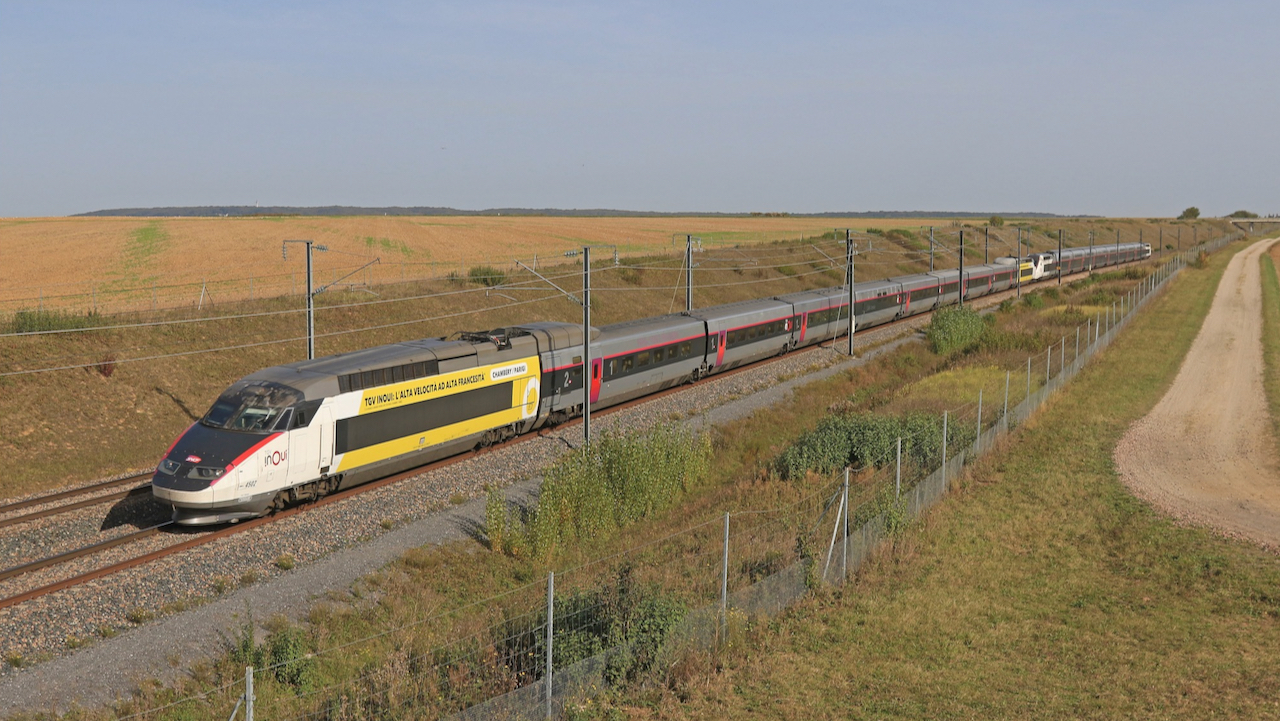
Since the closure of the Maurienne Valley Line due to the landslide near Modane in august, there has been no work for the small fleet of tri-voltage TGVs (4501-6) allocated to the Paris –Turin – Milan services. Set 4502 appears to have migrated to the LGV Est and is seen with its Italian markings on Sunday 8th October in multiple with Euroduplex 4712 at PK 14 near Charny (77) heading Train 2088 from Munich. Photo: Christophe Masse.
Botox to extend TGV lifespan
From 2024 the first phase of the project will cover 28 TGV Atlantique sets, 26 TGV Réseau dual-voltage sets, 21 TGV Réseau tri-voltage sets and six TGV Réseau sets used on the Paris – Lyon – Turin – Milan route, designed to extend their life by between two and four years. Each set will undergo an interior refurbishment lasting up to one month, with new seating, USB and power outlets, LED bulbs, toilets and bar car. The first renovated trains will operate on the Atlantique axis.
The second phase will start in 2026 and last until 2033 when 23 TGV Duplex sets will receive a mid-life overhaul taking up to six months that will extend their life until 2042. Interiors will be upgraded to Océane standard and mechanical and electrical equipment completely overhauled. This will include updating some equipment using TGV M technology to reduce energy consumption and improve reliability.
Opposite. The interior of Hellemmes Technicentre.
Photo: © Radio France/Raphael Ebenstein.
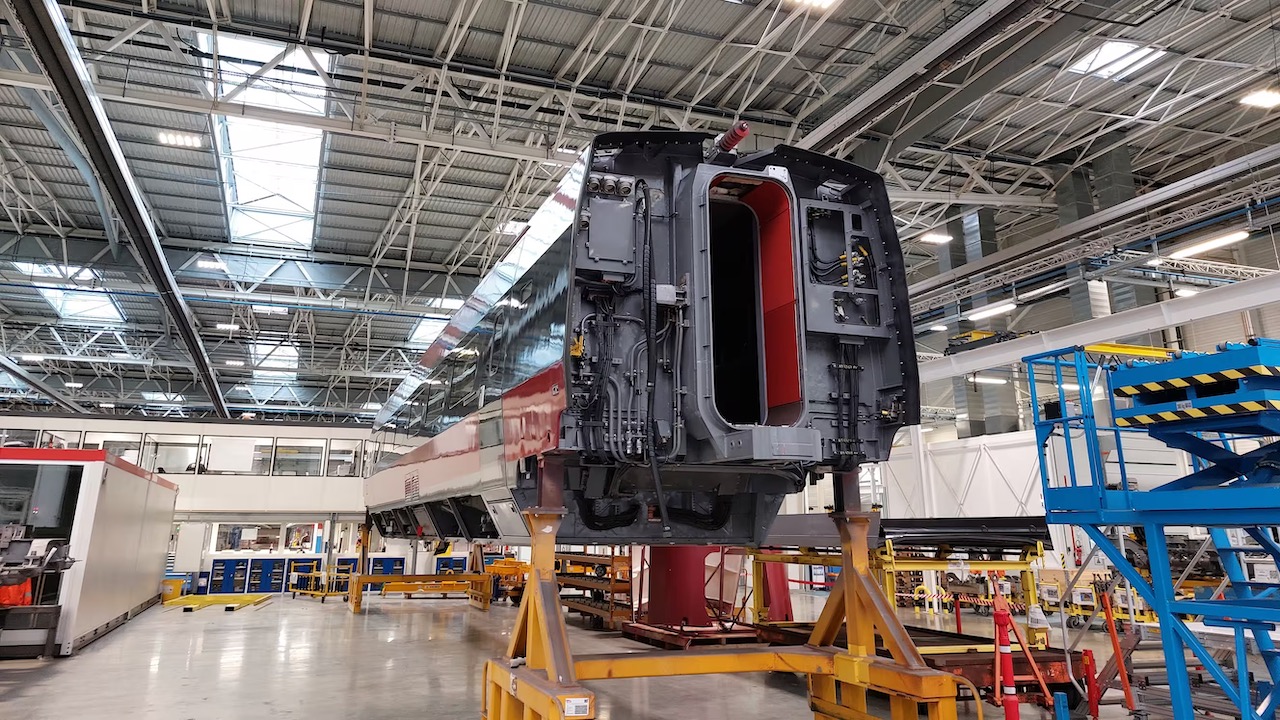
Work has started on an initial assessment of the frames, bodywork and mechanical components of the fleet, including ultrasound tests on wheels and axles to determine the condition of each set according to three criteria:
- Very good condition that only requires internal refurbishment.
- Needing more extensive work to improve reliability and lifespan.
- Poor bodywork or requiring major component replacement. These sets will be withdrawn and up to 3,000 components recovered from each set for use in refurbishing and maintenance of the remainder of the fleet.
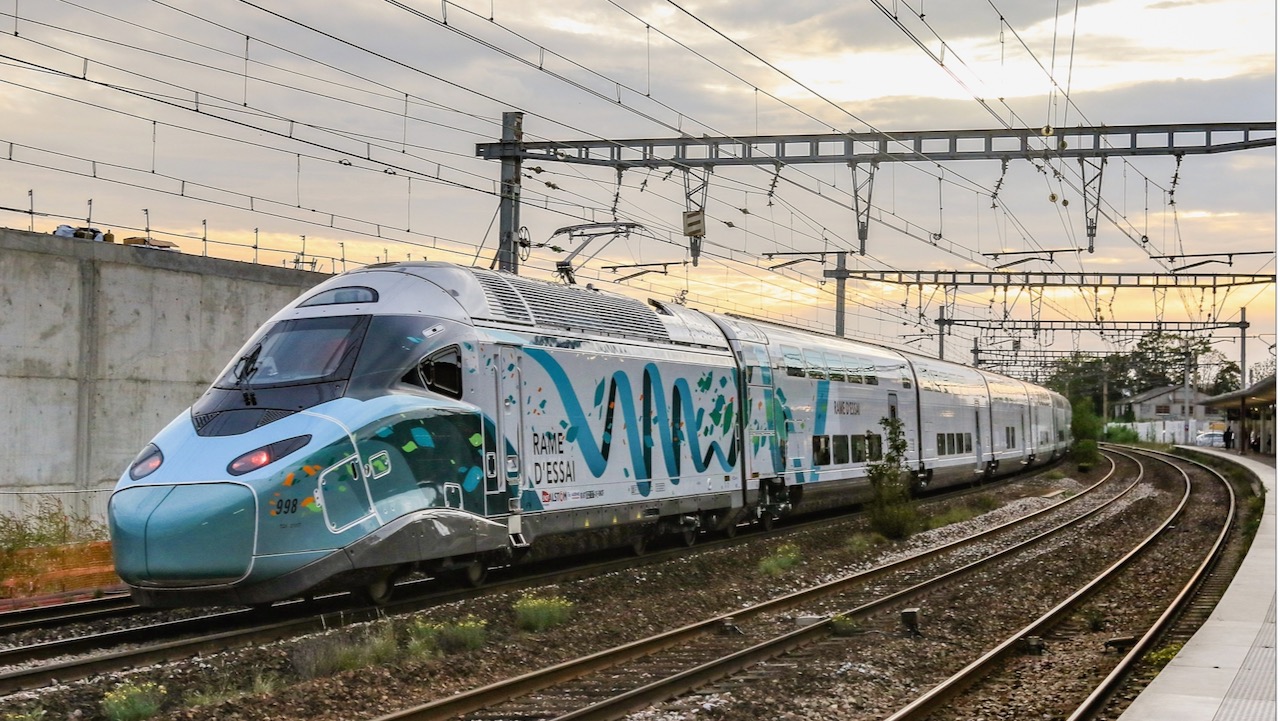
Second TGV M on test
The second pre-production TGV M set 998, known as PS3, has begun testing. It is seen opposite and above passing through Epinay-sur-Orge on Friday 13th October bearing a unique livery at each end following an internal Alstom and SNCF Voyageurs competition.
Overnight testing was scheduled to begin on the LGV Sud Europe Atlantique on the night of 15th October between Poitiers, Saint-Avertin and Pliboux. From January to July 2024 testing will be undertaken with sets working singly, in multiple, and partial failure modes to obtain authorisation for commercial service from the ERA (European Railways Agency)
Photos: Christophe Masse.
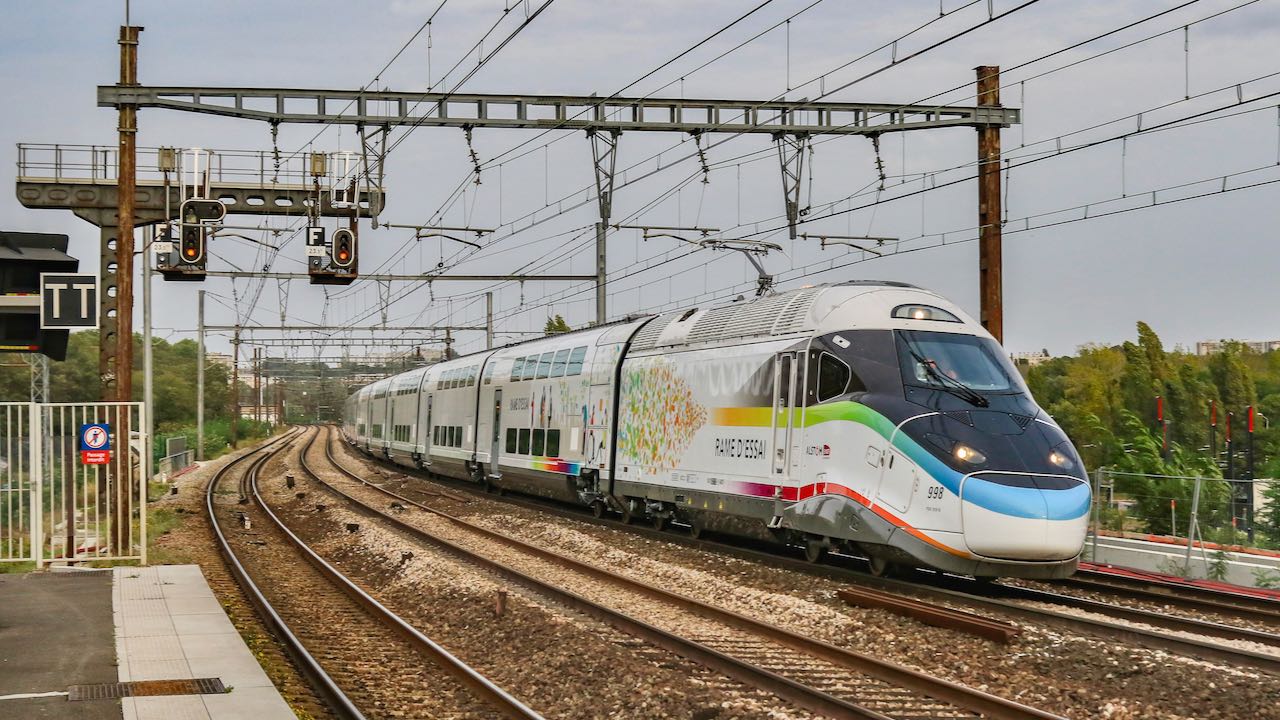
Evolyn to launch Paris – London service
As indicated in September News, high-speed start-up company Evolyn plans to introduce Paris – London services from 2025, competing with Eurostar for traffic through the Channel Tunnel. Evolyn is negotiating with Alstom to supply 12 trainsets from its Avelia range (these may be similar to SNCF TGV M – see photos above, although there are other options from within the range.) with an option for four more. Evolyn is a consortium including the Spanish Cosmen family (which has a stake in Mobico, previously National Express), with Jorge Cosmen as CEO and British and French industrial and financial partners.
Shortly after Evolyn's announcement, Alstom issued a statement clarifying the situation between the two companies: ’Alstom and Evolyn have established a short-term agreement to proceed with initial train system engineering activities with the objective of accelerating activities, should the parties eventually enter into a contract for the purchase and delivery of a certain number of trains, provided that Evolyn is capable of securing project financing’, it said. Given that Alstom has yet to start the production run of 115 TGV M sets for SNCF, it would be surprising if 12 sets could be ready in time for Evolyn to start operations in 2025, although with the takeover of Bombardier it does have options elsewhere.
Traxx MS3 on test
Traxx Universal MS3 188 003 was undertaking track-circuit acceptance tests at Plouaret-Trégor in early October. Following completion it was seen on 14th October being towed through Condé-sur-Huisne by Europorte E4040.
Railpool has ordered 50, and Akiem 65 (with an option for 35 more) of this latest version of the Traxx series, equipped with Alstom's Atlas onboard signalling to enable them to operate under both ETCS and legacy signalling systems in Germany, Austria, Switzerland, France, Italy, Belgium, Luxembourg and Poland. Some of the Akiem locomotives will also have 'last mile' diesel capability. Photo: Jocelyne Bourneuf.
Railpool has ordered 50, and Akiem 65 (with an option for 35 more) of this latest version of the Traxx series, equipped with Alstom's Atlas onboard signalling to enable them to operate under both ETCS and legacy signalling systems in Germany, Austria, Switzerland, France, Italy, Belgium, Luxembourg and Poland. Some of the Akiem locomotives will also have 'last mile' diesel capability. Photo: Jocelyne Bourneuf.
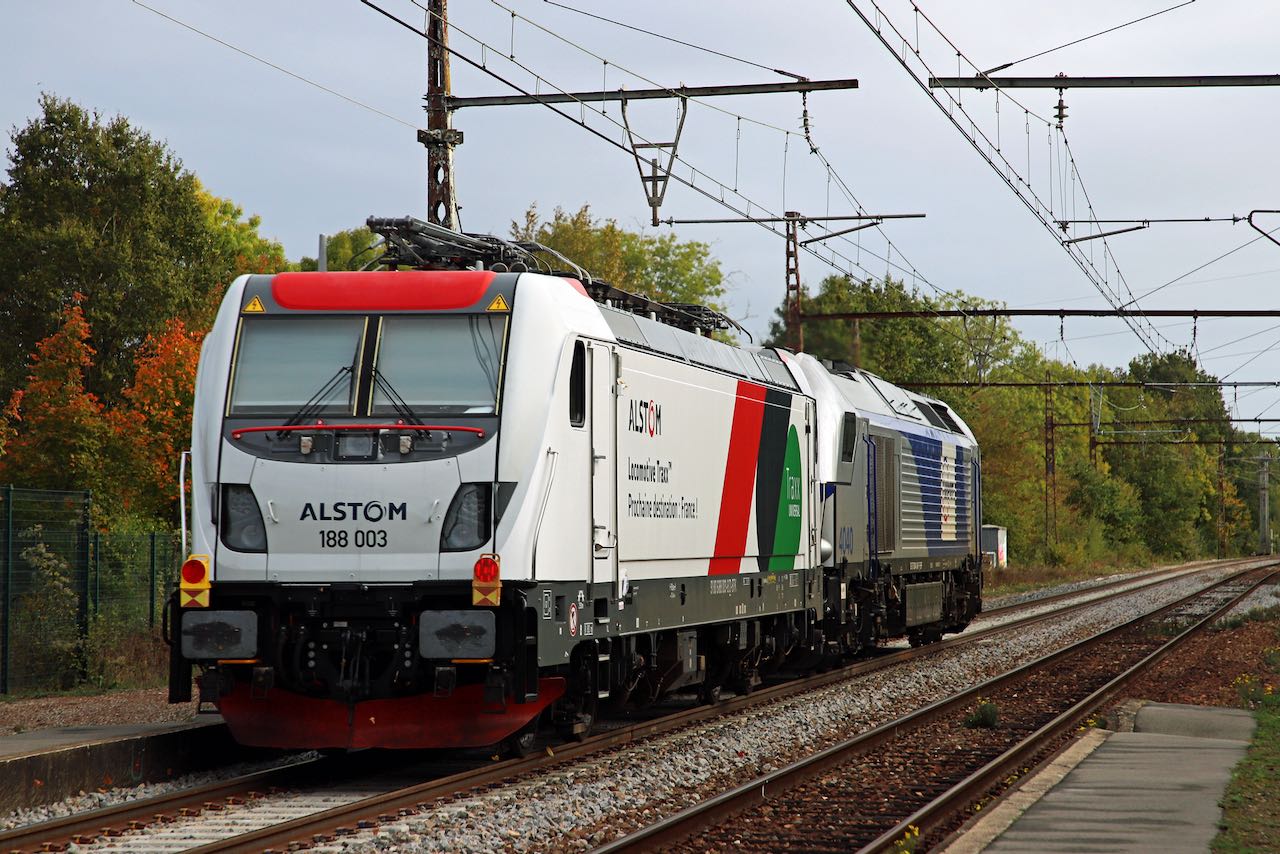
Lisea to build TGV depot
Sud Europe Atlantique LGV concessionaire Lisea is investing €150 million to build France’s first independent maintenance depot for high-speed trains. To be located at Croix de Hins (Marcheprime), 25km south of Bordeaux, Project SMR (Site de Maintenance et de Remisage) is part of Lisea’s effort to encourage new train operators to use its line. Lack of rolling stock maintenance and storage facilities is seen as one of the main barriers to entry for private-sector operators. Public consultation was conducted during 2022, and further meetings are currently taking place prior to an official public enquiry at the end of the year. Construction is expected to begin in early 2025 for completion in 2027.
A 14Ha site has been acquired for the depot, which will be configured to handle up to 15 trains. These will be mainly Trains Aptes à la Grande Vitesse in Lisea’s description, trains suitable for high-speed running, which could be serving Paris and Île-de-France or regional high-speed services such as those proposed by Le Train. The depot will not be dedicated to a single operator and will be equipped to service Régio2N, Régiolis and RER-style EMUs as well as the new trainsets on order for Intercités services.
Full maintenance, repair, testing, verification and cleaning facilities will be provided, along with overnight turnround and garaging. Around 200 jobs will be created.

Stringent environmental and noise regulations will have to be met at this afforested site located just outside the built-up area of suburban Bordeaux. Lisea aims to leave as small a footprint as possible and will make available for public use some 4Ha not required for the depot, as well as restoring or planting American red oak on 65Ha of adjacent land. Architect’s impression: L’Heudé et Associés/Lisea.
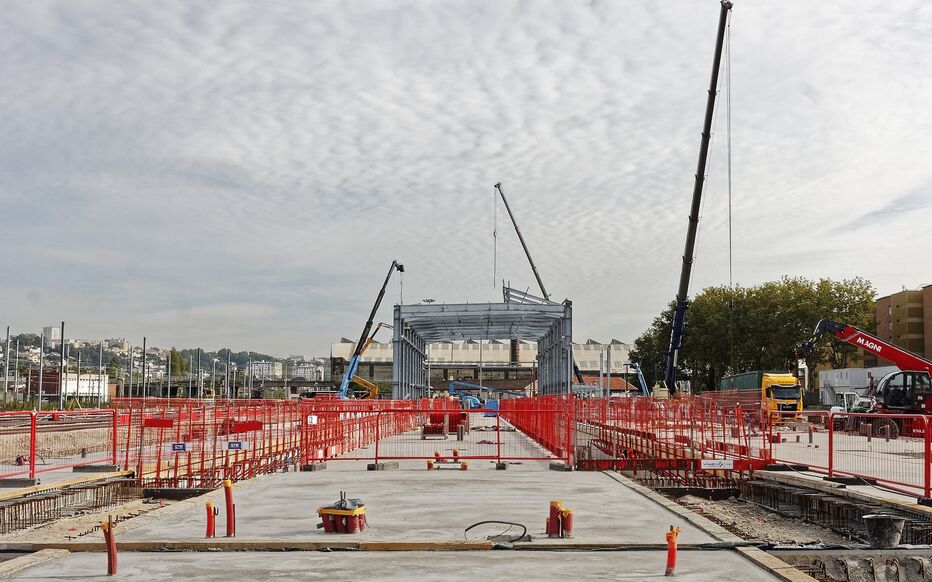
Le Havre Technicentre
Photo: Le Parisien.
Nevers – Dijon upgrade
The cross-country Nevers – Montchanin – Chagny – (Dijon) line is closed in sections for engineering work until 16th February 2024. €137 million is being invested to replace life-expired infrastructure: upgrading 121km of track, replacement of 104,000 sleepers and renewal or cleaning of 168,000 tonnes of ballast. The Arroux river bridge at Etang-sur-Arroux is being rebuilt, level crossing improvements carried out, and Decize and Montchanin stations made fully accessible. Line speed will be raised to 140km/h, reducing journey time between Nevers and Dijon by up to 20min.
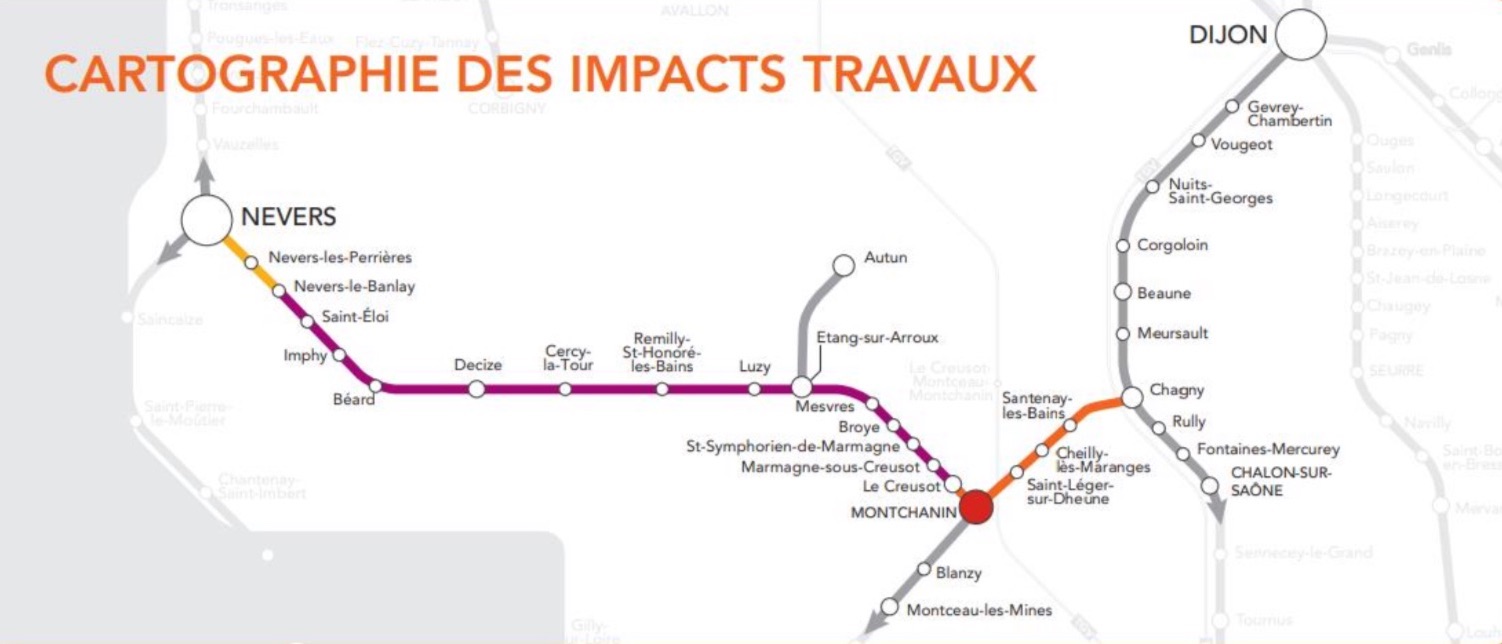
Nevers to Le Banlay (5km) was reopened for a limited train service on 3rd September; major track and bridge works between Le Banlay and Le Creusot (117km) continue until 23rd December. There will be no trains between Montchanin and Chagny until 16th February while 50-year-old infrastructure is renewed, leaving Montchanin served only by trains to Paray-le-Monial and Moulins. From 10th December the station will be closed for two months during accessibility works. Along this route, 50km of track is being relaid, 15 level crossings renewed, several viaducts refurbished and drainage courses rebuilt. Stations at Saint-Léger-sur-Dheune, Cheilly-lès-Maranges and Santanay are being brought up to modern standards of accessibility, with 55cm high platforms and improved lighting.
Some 550 staff are involved, working from the SNCF maintenance depot at Saincaze-Meauce south of Nevers. Cost of the work is shared between SNCF Réseau (€75 million), the State and Bourgogne-Franche-Comté region (€62 million).
More than 90 buses have been mobilised to provide replacement services. While this was satisfactory during the summer holidays, the buses are reported to have been overwhelmed by passengers returning to school and work. The 15km branch from Etang to Autun, stub end of the line that ran north to Avallon and Auxerre, is cut-off by the works and no trains are running.
Opposite. Preparations for the new bridge at Etang-sur- Arroux. Photo: Région Bourgogne-Franche-Comté.
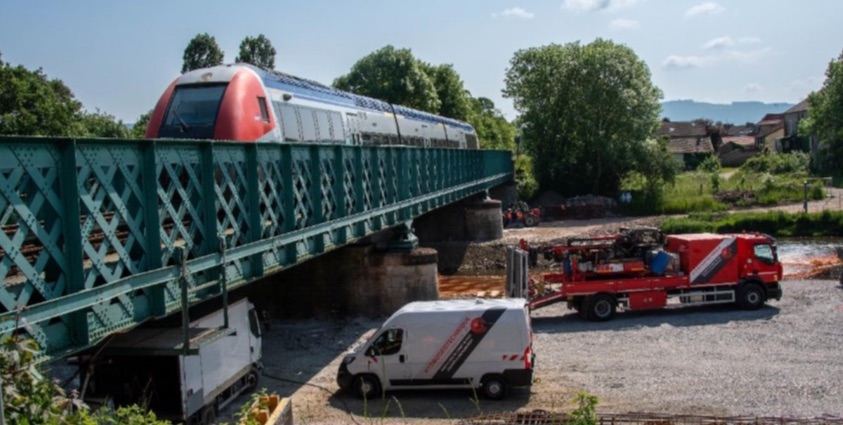
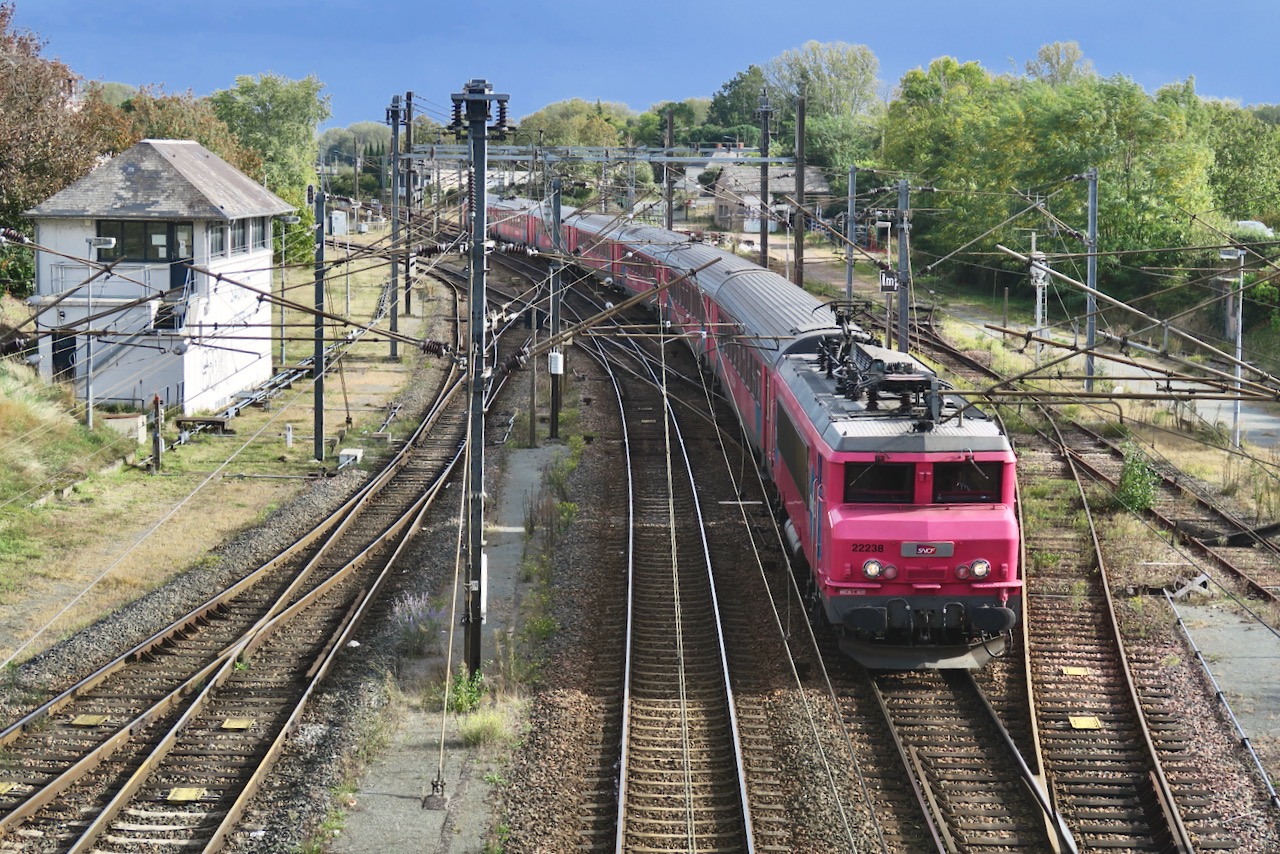
BB 22338 arrives at Saumur on the 21st October with Ouigo Classique 4089 12.44 Paris Austerlitz – Nantes. It is seen above crossing the junction of the line to Thouars and La Roche-sur-Yon, still referred to on the PN numbers as the Chartres – Bordeaux line. While the area is controlled by colour light signalling all of the pointwork at the junction is still operated mechanically from the Poste.
Newsdesk
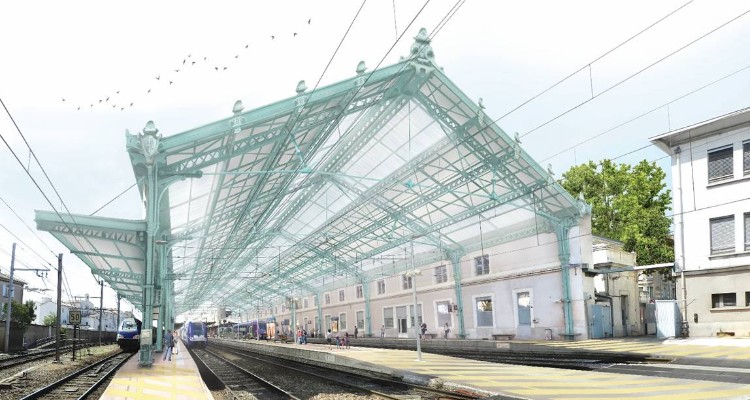
Valence restored. Completion of two years’ work on the overall roof at Valence-Ville was marked at a ceremony on 9th October. The 97m long structure, built for Saint-Germain-des-Fossés in 1860 and re-erected at Valence in 1903, has been restored and reglazed with the aid of information from the original plans.
Photo: SNCF Gares et Connexions.
New phase of POLT upgrade. The latest stage in the Paris – Orléans – Limoges – Toulouse modernisation started on 8th October. The 81km between Orléans and Vierzon is being upgraded in four stages at a cost of €90 million, with this year’s activity seeing a Boa factory train at work overnight between Orléans and Nouan-le-Fuzelier (47km). Up and Down lines will be tackled in several stages concluding with the 22km between Salbris and Vierzon in 2027.
Booking sites saturated. Opening on 4th October of booking for Christmas and New Year travel saw big increases in demand for reservations. SNCF reported a million connections/min between 07.00 and 08.00, 230% more than last year, leading to some 3,000 bookings/min; at Trainline connections were up 175%.
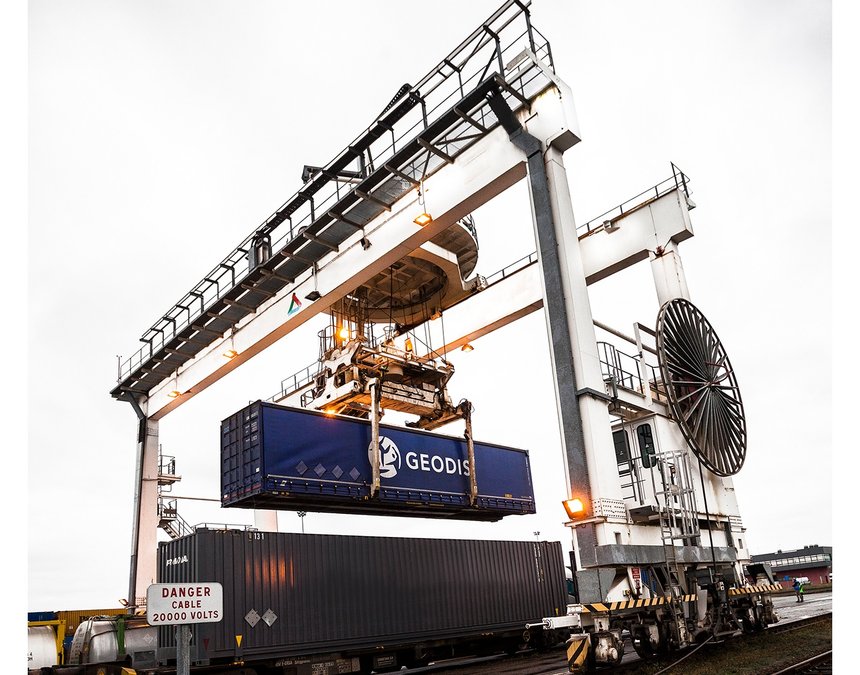
Puyoô rail-road terminal. Geodis has invested €1 million in a road-rail transfer terminal at Puyoô in Pyrénées-Atlantiques, where redundant sidings have been rehabilitated and a container crane installed. Two trains a week with capacity for 64 TEU will run to the yard at Lavera (Martigues) near Marseille. The intention is to halve the number of lorries hauling containers from southwest to southeast France.
Photo: © Franck Vogel.
MI20 trains delayed. Delivery of MI20 EMUs for Paris RER Line B, scheduled to start at the end of 2025, will not now begin until early 2027. Alstom cited design difficulties and ‘technical challenges greater than we had expected’ in development of the new-generation trains.
Line 4 safety trials. New procedures for managing in-tunnel stoppages were tested on metro Line 4 in Paris overnight during the week of 18th September. This follows the incident on 14th June when several hundred passengers were stranded underground (see July News).
Bed bugs bite. Complaints about punaises de lit (bed bugs) in train and metro seating (and elsewhere) led transport minister Clément Beaune to call operators together on 4th October to discuss hygiene and preventive measures. Investigations had found no evidence of widespread infestation; nevertheless SNCF, RATP and Eurostar took immediate steps to reassure passengers.
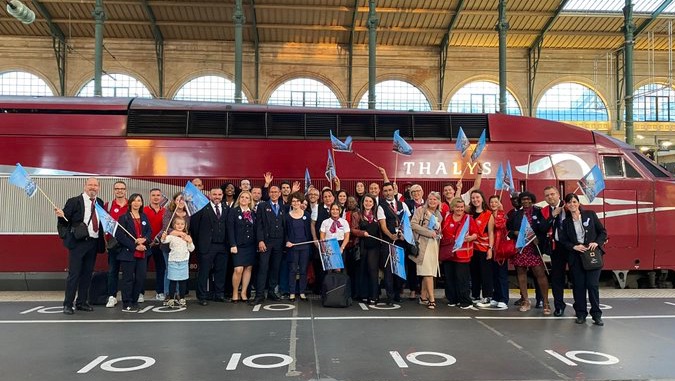
Au revoir Thalys, rebonjour Eurostar. The last trains under Thalys branding ran on 30th September, concluding with the 19.21 from Paris to Brussels (pictured). New publicity shows the Eurostar network linking Paris with Lille, London, Brussels, Amsterdam, Cologne and Dortmund, marketed as ‘the backbone of sustainable travel in Europe’. Border control problems have eased, enabling Eurostar to dispense almost entirely with the limit on seat sales between London and Paris. Strong demand during the Rugby World Cup saw St Pancras handling around 18,000 passengers a day in early October. Photo: Eurostar.
Burgundy Corail finale. In a ceremony at Laroche-Migennes on 17th October elected officials from Burgundy Franche-Comté formally accepted the last of 24 Class Z 54500 Régiolis units. Costing €458 million, the new units will replace BB 7200 and Corail stock on the Paris – Dijon – Lyon axis.
Lille Recruitment Fair. Recruitment still remains a major issue for SNCF. On the 12th October a recruitment fair was held at Lille to fill 1,000 vacancies in the area. Opportunities were available in all departments, particularly for rolling stock and track technicians
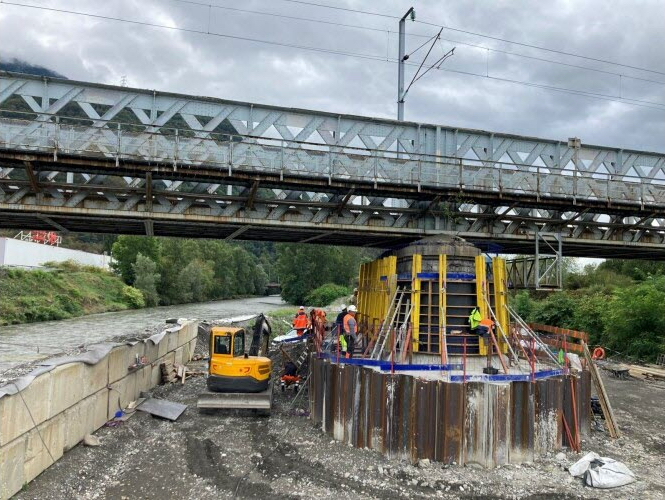
Albertville bridge. Work has started on the second phase of a two-year modernisation of the pont d’Arly on the Bourg-Saint-Maurice line in Albertville. The decking of the 130-year-old girder bridge is being replaced and piers strengthened at a cost of €8.5 million. The new deck will be positioned during a week-long closure next summer. Photo: Le Dauphiné Libéré/JB.
Le Mans keeps control. The signalbox and control centre at Le Mans is to be retained rather than have its work transferred to Rennes as had been planned. SNCF Réseau responded to months of sporadic strikes by reversing its decision to close the box, saving 40 jobs.
Rennes 2TMV. France’s first resignalling to allow two trains to occupy the same platform of a through station, so-called 2TMV (2 trains sur un même voie), was inaugurated at Rennes on 5th October by transport minister Clément Beaune. At a cost of €15 million, capacity has been increased by 30%. From next September a further 24 TER services will be added to the timetable.
Auchan must pay SNCF. Ceetrus, the property arm of supermarket group Auchan, has lost its action against SNCF over the aborted renovation of Gare du Nord. SNCF had originally sued the developer over huge cost increases which helped scupper the scheme in 2021; Ceetrus counter-sued for breach of contract. On 22nd September the Paris Tribunal de Commerce ordered Ceetrus to pay €47 million to SNCF, which is seeking a further €300 million compensation for the failed project.
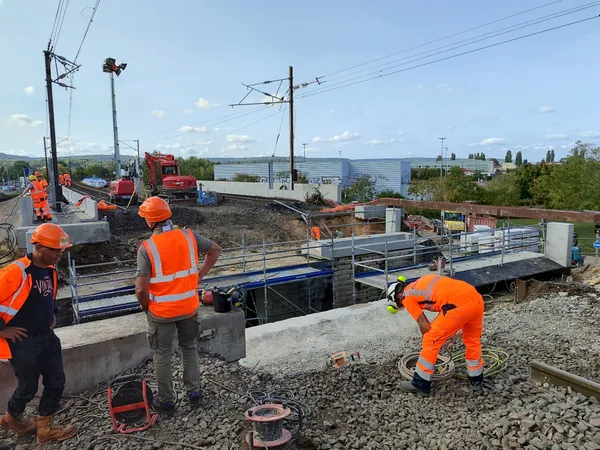
Metz platform lengthening. Major works were carried out at Metz-Nord over the weekend of 30th September to widen an underbridge so that platforms can be lengthened to 250m. Seven stations between Metz and Thionville are being modified to accommodate eight-car trains. Last year saw work at Hettange-Grande, Uckange, Hagondange and Walygator, whilst Metz-Nord, Maizières-les-Metz and Woippy should be completed by December. Photo: Radio France/Doris Henry.
Saint-Malo growth. SNCF is to look at improving Saint-Malo station to cope with passenger numbers which have tripled since electrification in 2005, to 1.6 million a year. As well as the main building, changes to the forecourt, parking, bus station and access roads will be considered.
Night Train refurbishment. By the end of the year, the Technicentres at Périgueux and Tergnier will have refurbished 93 couchette cars for Intercités Trains de Nuit at a cost of €91 million. These were vehicles previously withdrawn from service. Now they are being allocated to the following routes: Paris – Briançon (35), Paris – Latour de Carol/Rodez/Cerbère (36), Paris – Nice and Paris – Tarbes (22).
First Transilien concession. Ile-de-France Mobilités has chosen a joint venture of SNCF Voyageurs and Keolis to operate tram-train routes T4 and T11 and the Esbly – Crécy-la-Chapelle branch of suburban Line P starting in March 2025. Amounting to 2.9 million train-km/year, this is the first lot of Transilien services to be opened to competition.
Training on the move. SNCF’s Le Mans training centre, which welcomes some 9,000 students annually, is to move into new buildings at the end of 2025. With the lease on the current site running out, a new campus is being built on the former Renault sports ground about 2km from the city’s main station. In the new competitive environment, the centre will be open to trainees from companies other than SNCF.
Valdunes rescue? The State and Hauts-de-France région have committed to financial support to save Valdunes, France’s only remaining wheelset manufacturer. The company’s two works and 345 jobs are in danger following withdrawal of Chinese shareholder Ma Steel. Takeover by an Alstom/SNCF consortium, proposed by the CGT union, was rejected but the two companies have agreed to be ‘responsible customers’ for Valdunes’ products. Despite interest from several quarters, a serious buyer has yet to be identified.

Ligne des Causses
As previously reported, BB 60000s have started to replace BB 67400 on the Clermont-Ferrand – Saint-Chély-d’Apcher steel trains. This is a stop-gap measure pending replacement of the track to enable BB 75000 to operate south of Neussargues. At present there is still no agreement on funding for the track upgrade. As not all drivers have been trained on BB 60000s, a mix of BB 60000s and BB 67400s will operate for the immediate future.
Further south, the section between Bédarieux and Millau will remain closed until next year while repairs are undertaken by 60 SNCF Réseau staff and contractors. The estimated €10 million cost will be met by SNCF Réseau. Repairs are required on 14 structures, two retaining walls and two tunnels. Restoring the 10km of damaged track will require 5,000 new sleepers, 6,000 metres of rails and 10,000 tonnes of ballast. A number of electrical installations also need replacing including 2,000 metres of telecom cables and a number of catenary poles.
Above. On 27th September BB 60115/60018 are seen crossing the Garabit Viaduct, and below passing through Talizat with a southbound steel train. Photos: Georges Turpin.
Storm damage north of Millau was less severe and speedily repaired. Operation of trains had initially been ruled out as EMUs could not reach their maintenance facilities at Béziers and there are few crew with route knowledge. However, with strong pressure locally for trains to resume, both issues have been addressed on a temporary basis. An agreement between SNCF, the CGT Cheminots union and the région allowed resumption on 17th October of a single daily return train from Millau to Saint-Chély-d’Apcher (the northern boundary of Occitanie), outward at 08.34 returning at 11.30. However, this is of limited use as SNCF Intercités refused to provide a connecting train northwards to Neussargues.
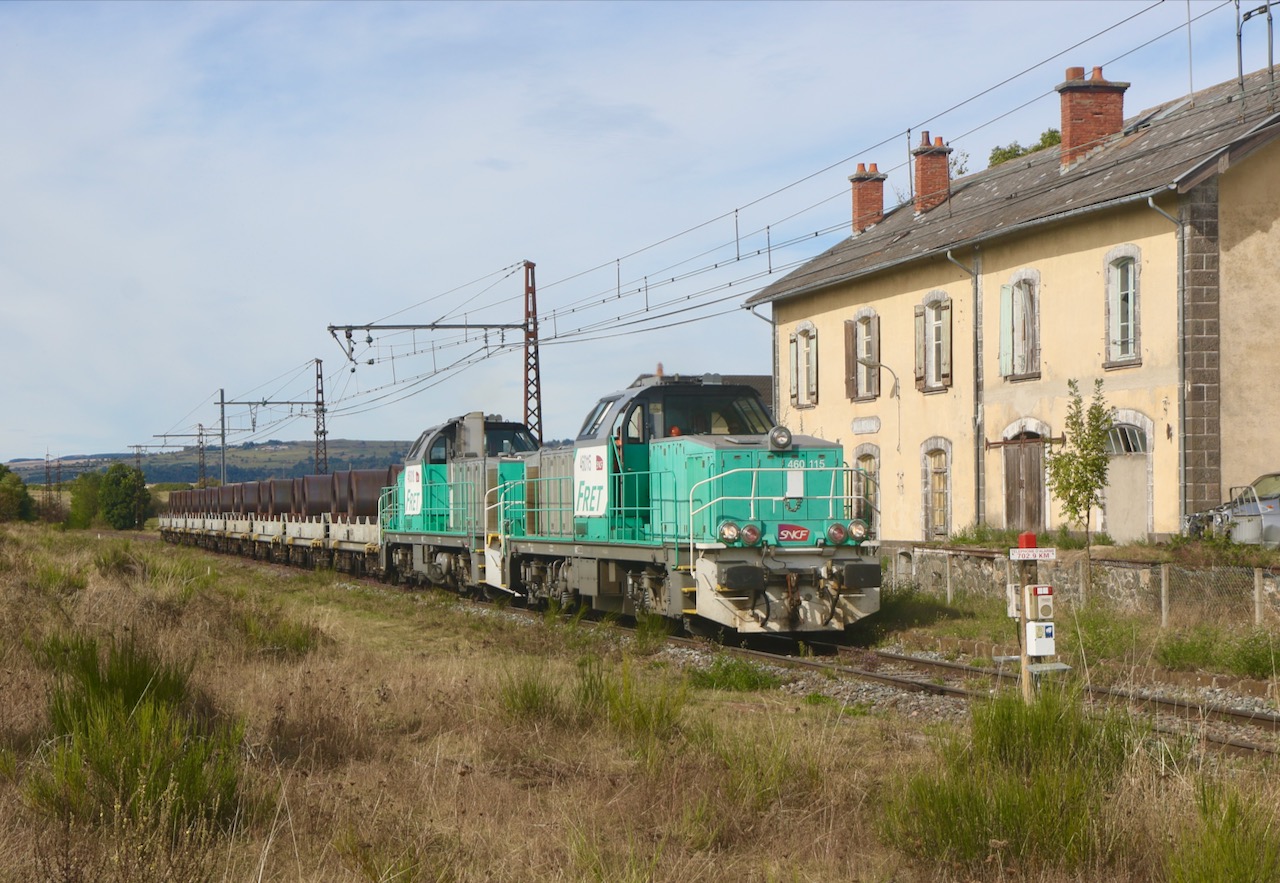
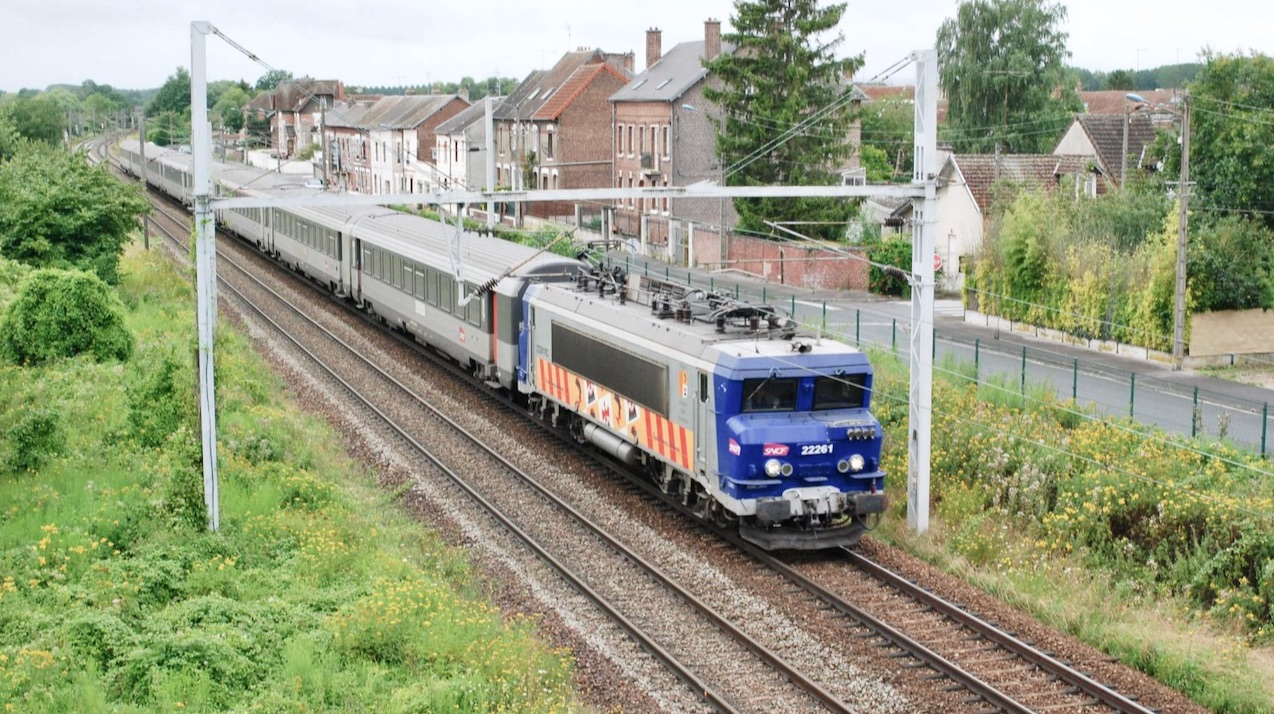
End in sight for Hauts-de-France locomotive-hauled
Between May and the end of July, 10 of the 19 Omneo Premium XL units ordered to replace the remaining loco-hauled services from Gare du Nord had been delivered and were in service. During August, reduced services around Lille provided no work for the BB 22200 push-pull fleet and some were drafted onto Paris Corail services. Seen above is BB 22261, still in PACA livery, at Chauny on 9th August with Train 847909 09.18 Gare du Nord to St Quentin. Omneo Premium XL 144 (Z 55787/5507788) was the last of the 10 sets, entering service on 31st July. It is seen below at Maubeuge on 11th August after arrival with Train 16457, the 17.18 Paris Nord. Externally the Hauts-de-France Omneo Premium units appear the same as the former Picardie Regio 2N XL units but have a different internal layout. Photos: Michel Joindot.
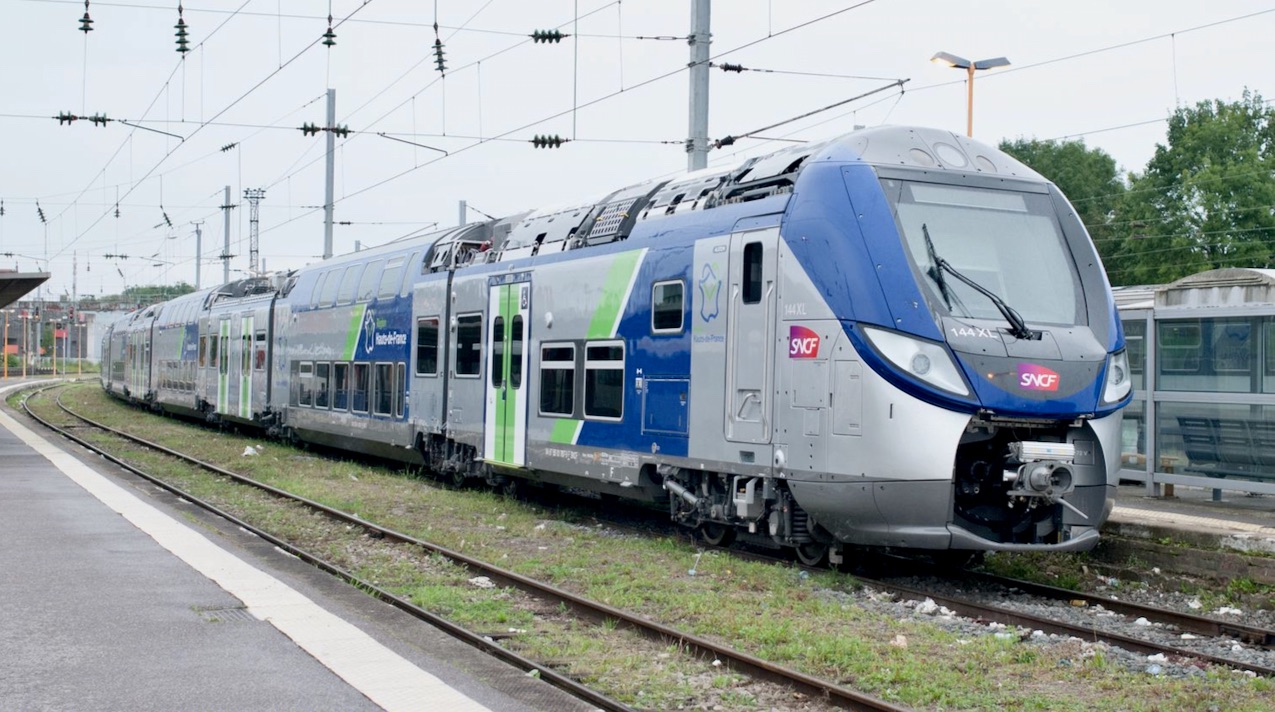
Railcoop in Administration
Although having over 14,500 individual, corporate and civic members, Railcoop struggled to raise capital to fund the proposed service. Eight former AURA Class X72500 units had been earmarked for purchase and mid-life overhaul to operate Bordeaux – Lyon and other proposed services, but money could be found to buy and restore only one three-car unit plus a two-car set for spares. This would have been sufficient to start the Bordeaux – Lyon service in 2024 with three return trips a week.
In November 2021 Railcoop began a local freight service from Capdenac to Saint-Jory yard (Toulouse) that was later extended to Saint-Gaudens, using wagons leased from Erwema and G1000 locomotives from ECR. On 29th March a second freight service was started from Gignac-Cressensac, between Brive and Souillac, but on 19th April all freight operations were suspended so that management could focus resources on the proposed Bordeaux – Lyon passenger service. It was reported that running costs had exceeded €4 million, against receipts in 2022 of €120,000.
During the summer a major fund raising exercise took place to raise €500,000, this included members being offered a €40 travel voucher for €30, but this failed to reach the target amount. Railcoop expressed disappointment that few local or regional councils in areas to be served by the Bordeaux – Lyon trains were prepared to offer loans or guarantees. Those that did, such as Guéret (€7,100 in shares), préfecture of Creuse département, are left wondering if they will see any return on their investment. Serena Partners, a Spanish investment fund specialising in infrastructure financing, was willing to be part of a consortium but not the sole financier.
Mont d'Ambin Base Tunnel Lyon – Turin update
At the beginning of September the last major civil engineering contract worth €1.1 billion was awarded to a consortium of French group Spie Batignolles and Italian companies Itinera and Ghella. The contract is to dig two 13km tunnels on the Italian side of Mont d'Ambin. Two tunnel boring machines and 700 workers will be employed with construction to be completed by 2030.
On 6th October the second of the five tunnel boring machines that will work on the French section of the base tunnel was unveiled at the Herrenknecht construction plant in Schwanau, Germany. Measuring 10.5m in diameter and 180m long, once testing is complete the 254 tonne machine will be dismantled and transported to bore 9km of tunnel under the Alps at Saint-Martin-la-Porte in La Praz (Savoie).
At the peak of activity in 2025, five of these machines be will working simultaneously on the French side.
News that the Maurienne Valley line could be closed for up to a year following the landslide at Freney, west of Modane, at the end of August has created a stronger case for the base tunnel according to its supporters.
Geological factors are proving difficult to resolve, and it is argued that the base tunnel will provide a more reliable route as the area faces increasingly unpredictable weather with global warming. The illustration opposite shows the position of the current line with 1 in 30 gradients and the base tunnel with a maximum of 1 in 80.
Photos: Transalpine

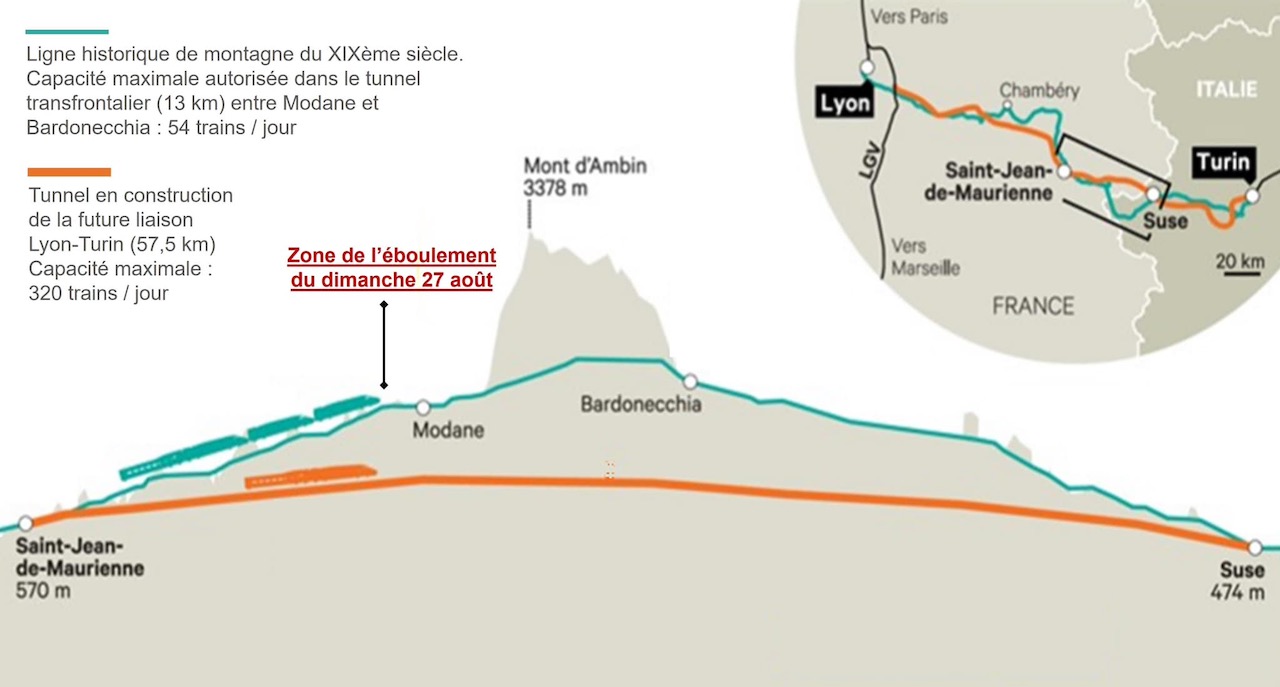
There is some concern that the French government is dragging its heels in applying for EU funding to help finance construction of the approach lines to the tunnel from Lyon (see May News). Transport Minister Clément Beaune has said that the State is ready to invest €3 billion in the project, but the complete financial plan is still to be defined with Auvergne-Rhône-Alpes région. The EU has previously indicated it would meet between 40 and 55% of the cost. Applications for funding major transport infrastructure projects need to be lodged with the EU by the end of January, or will have to wait until 2028 for the next funding round.
France plans to build separate high-speed passenger and freight lines between Lyon and Saint-Jean-de-Maurienne. The passenger line will link with LGV Sud-Est south of Lyon Saint-Exupéry and connect near Chambéry to the Annecy via Aix-les-Bains and the Bourg-Saint-Maurice via Albertville lines. It may also carry TGV traffic from the saturated Lyon – Grenoble line. The freight route will start from a connection to the future Lyon freight bypass and will run south of Chambéry. The separate freight line will divert freight traffic away from Aix-les-Bains and Chambéry as well as from the shores of Lac du Bourget where a freight accident on the existing line could catastrophically pollute this major natural freshwater reservoir.
France plans to build separate high-speed passenger and freight lines between Lyon and Saint-Jean-de-Maurienne. The passenger line will link with LGV Sud-Est south of Lyon Saint-Exupéry and connect near Chambéry to the Annecy via Aix-les-Bains and the Bourg-Saint-Maurice via Albertville lines. It may also carry TGV traffic from the saturated Lyon – Grenoble line. The freight route will start from a connection to the future Lyon freight bypass and will run south of Chambéry. The separate freight line will divert freight traffic away from Aix-les-Bains and Chambéry as well as from the shores of Lac du Bourget where a freight accident on the existing line could catastrophically pollute this major natural freshwater reservoir.
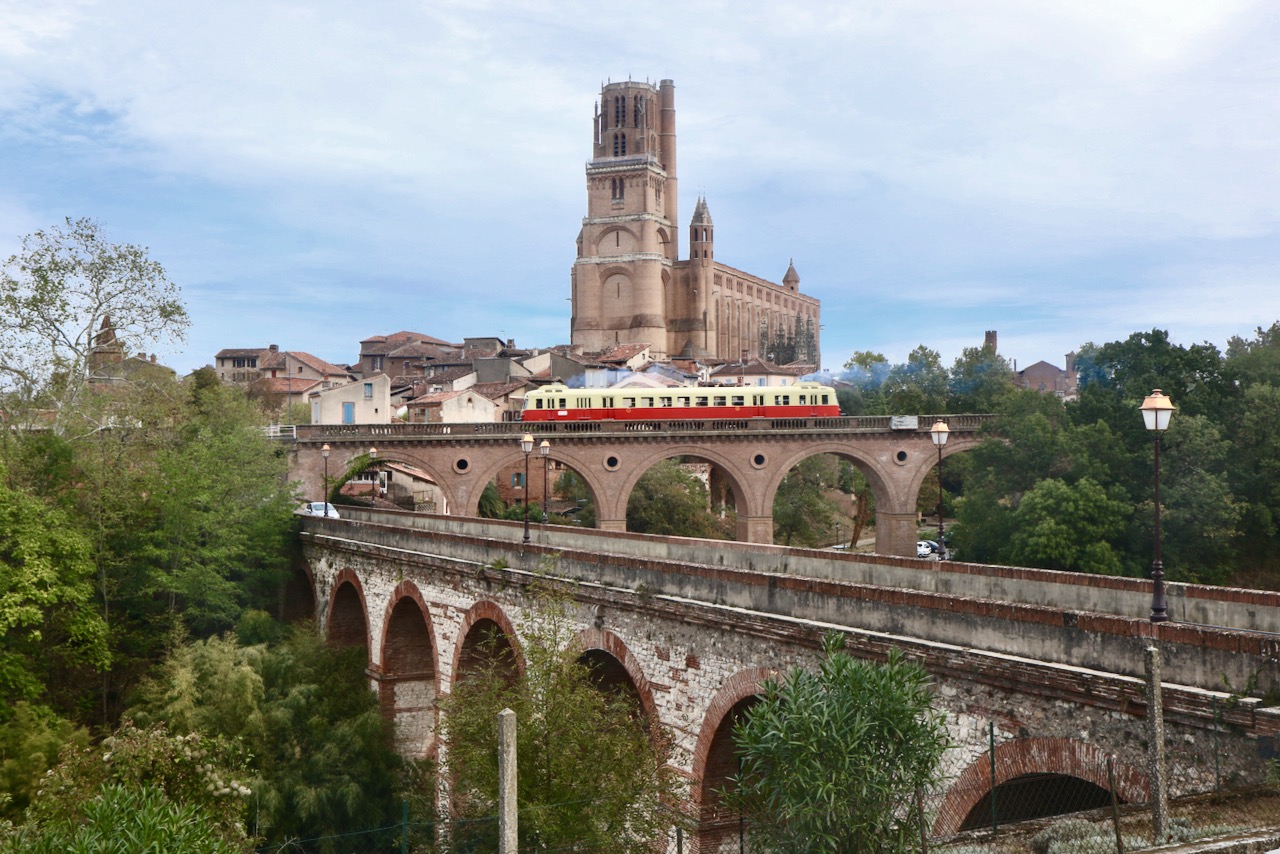
Over the weekend of 21st/22nd October l’Association des Chemins de fer de la Haute Auvergne operated a tour on the west side of the Massif Central from Ussel to Albi with preserved autorail X2403. Travelling south on the Saturday via Brive, Capdenac, Lexos and Tessonnières, on the Sunday it returned to Ussel via Rodez, Capdenac and Brive. Seen above shortly after leaving Albi on the return, crossing the Merville Viaduct with the imposing brick built Sainte-Cécile Cathedral in the background. The two trails of exhaust indicate that both engines are working. Photo: Georges Turpin.
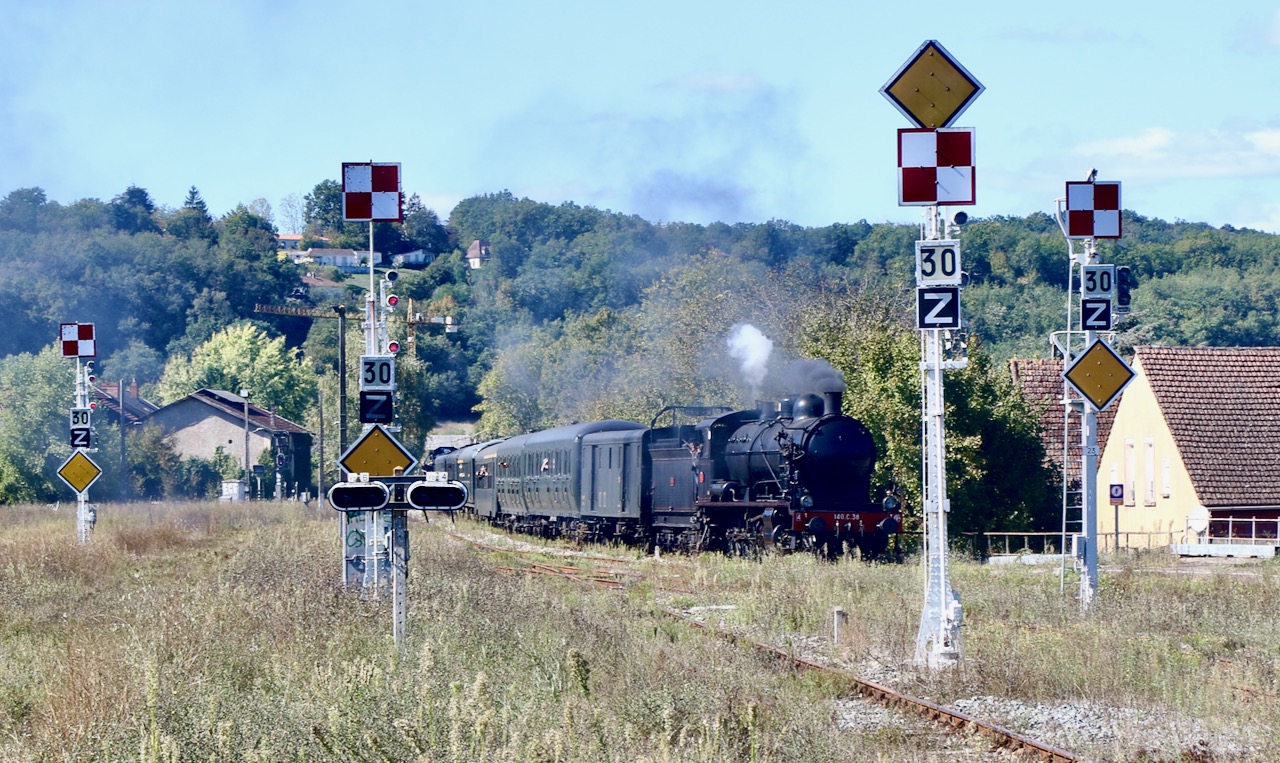
To mark the 100th anniversary of the Musée National de la Préhistoire at Les Eyzies, CFTLP (l'association Conservatoire Ferroviaire Territoires Limousin Périgord) was asked to run ran a steam special to celebrate the event. This was to reflect the fact that when the Musée opened in 1923 most visitors would have arrived by train. Headed by 140 C 38, it left Limoges on the afternoon of Friday 29th September, travelling as far as Périgueux. With seven coaches, a wagon with coal and hydraulic crane to replenish the tender and BB 69421 at the rear, the trailing load was approaching 500 tonnes.
The following morning the special steamed out of Périgueux, arriving at Les Eyzies just over an hour later and continuing to Le Buisson in the afternoon.
Above 140 C 38 arrives at a weed strewn Le Buisson passing one of the few remaining arrays of carrés.
Opposite. Leaving Thiviers on the 29th September. The yard is still used by two stone trains a week from a nearby quarry, one for Bordeaux Hourcade, the other for Saint-Jory.
Below. CFTLP has painted BB 69421 in a dark blue livery, seen leaving Bussière-Galant at the rear of the train, next to the coal wagon.
All Photos: Georges Turpin.
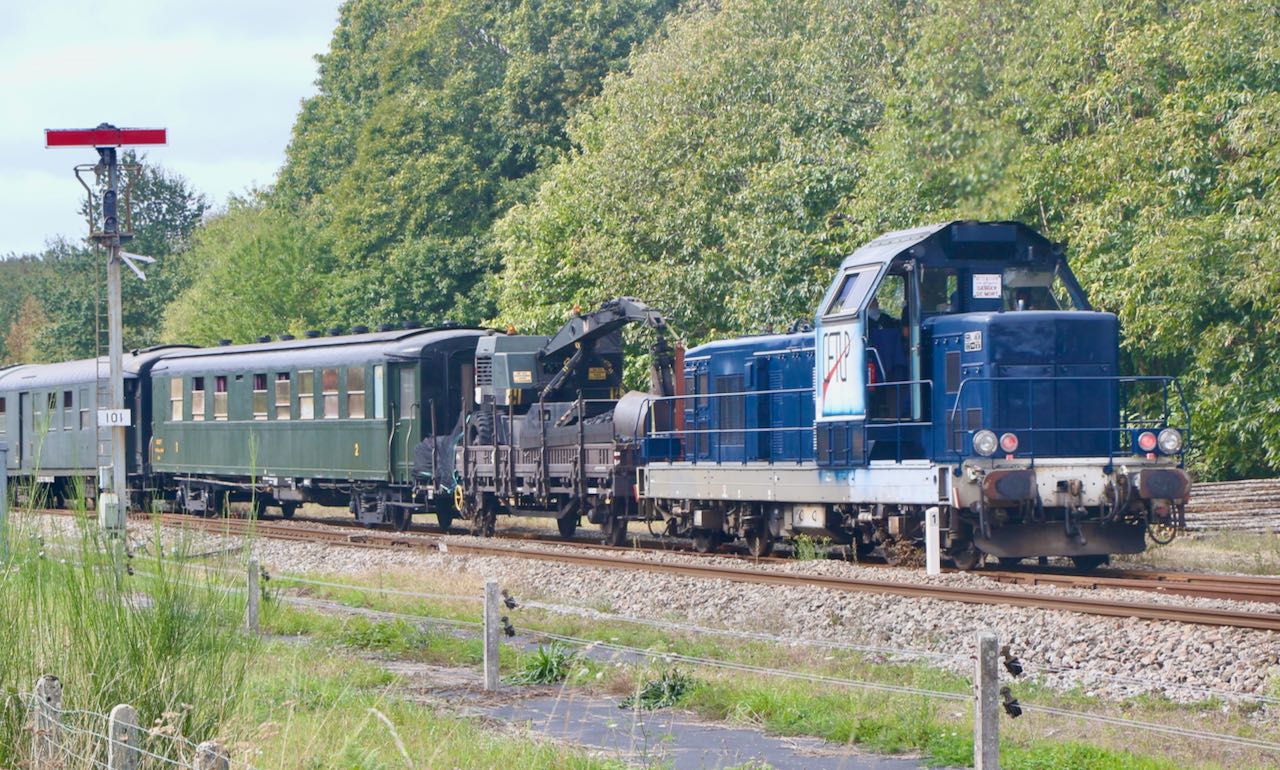
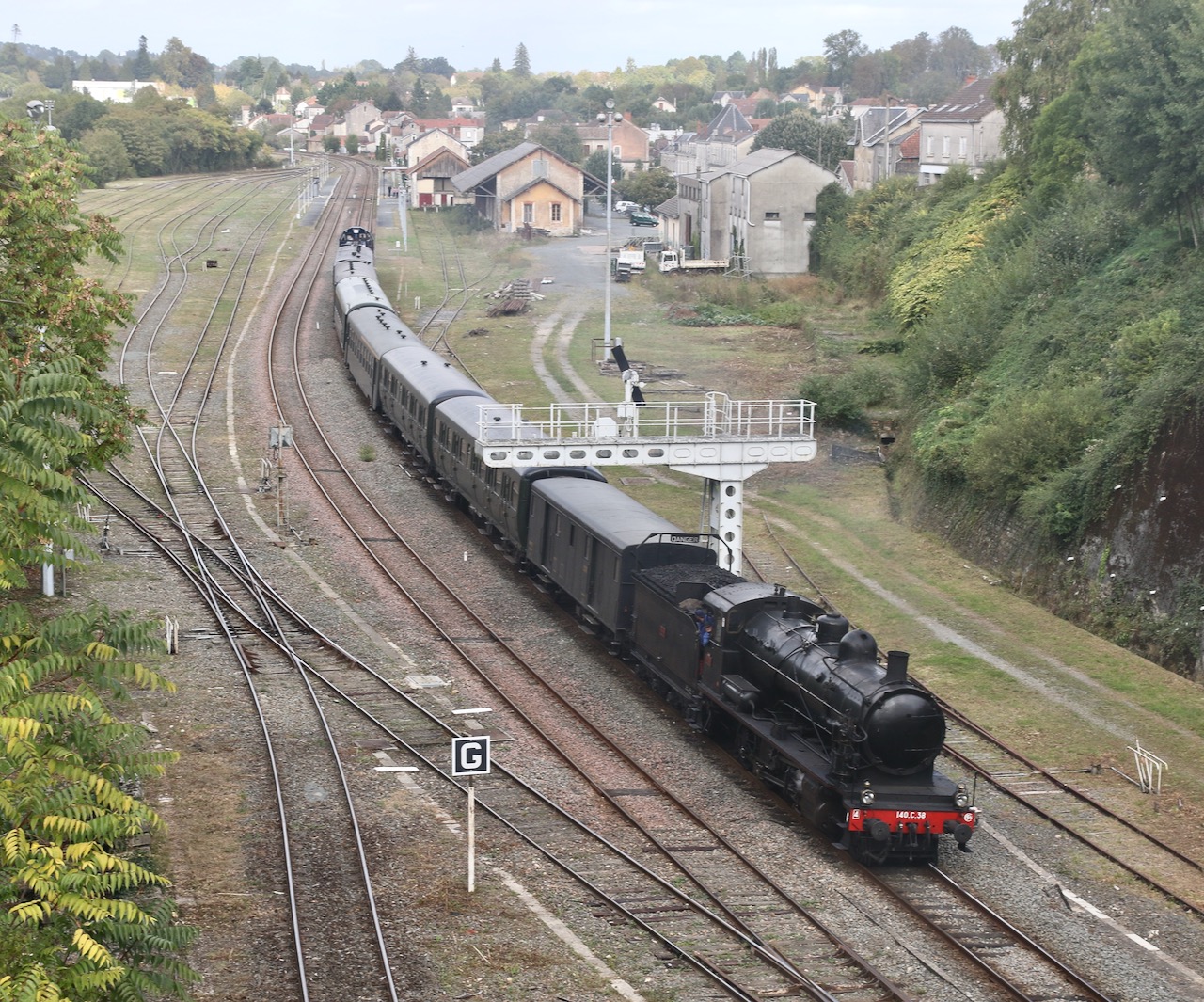
Provins – Villiers-Saint-Georges closed
With no notice or consultation, SNCF Réseau has closed the line to Villiers-Saint-Georges beyond Provins, presumably due to the poor condition of the track. It had been used to transport cereals and for tourist steam trains operated by Longueville-based AJECTA. In recent years cereals cooperative Cérèsia has exported about 50,000 tonnes of grain a year from silos at Villiers-Saint-Georges, requiring about 25 rail freight movements annually.
The move is bitterly opposed by the Communauté de communes du Provinois as it will bring an additional 2,000 heavy lorry movements through the town annually. In recent years CCP has invested nearly €200,000 to improve the tourist potential of the line, with €50,000 spent on track repairs as well as improvements to Villiers-Saint-Georges station and contributions to AJECTA for steam locomotive repairs.
AJECTA has been forced to cancel the planned Halloween trains, but will run Père Noël specials in December from Longueville to Romilly-sur-Seine.
The move is bitterly opposed by the Communauté de communes du Provinois as it will bring an additional 2,000 heavy lorry movements through the town annually. In recent years CCP has invested nearly €200,000 to improve the tourist potential of the line, with €50,000 spent on track repairs as well as improvements to Villiers-Saint-Georges station and contributions to AJECTA for steam locomotive repairs.
AJECTA has been forced to cancel the planned Halloween trains, but will run Père Noël specials in December from Longueville to Romilly-sur-Seine.
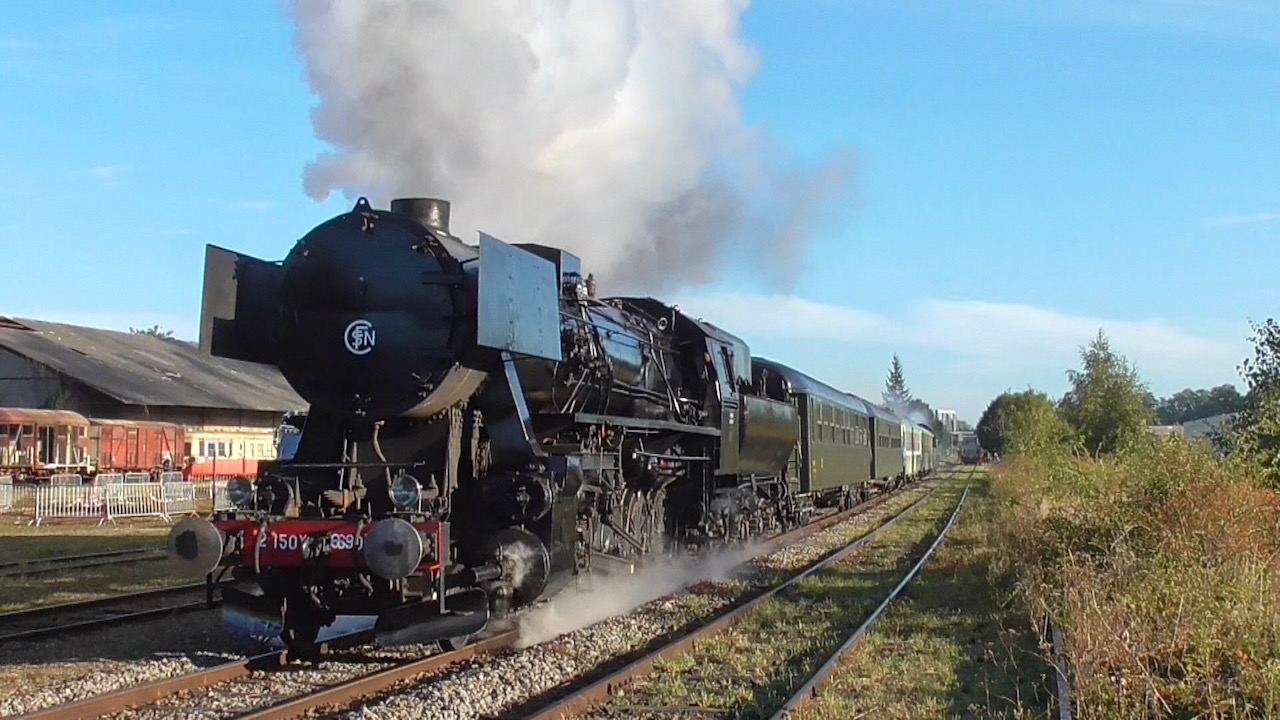
CFTVA celebrates Ty2 6690's 80th birthday
The weekend of 29th September - 1st October saw CFTVA (Chemin de Fer Touristique de la Vallée de l'Aa) celebrate the birthday of Polish 2-10-0 Ty2 6690. The event started on 28th September when CC 72084 and BB 66170 bought Pacific Vapeur Club’s rake of historic coaches from Sotteville to provide additional coaching capacity.
For the event Ty2 6690 was given SNCF markings as 150 Y 6690 (see above). Visiting from the Chemin De Fer De La Vendée was SACM 0-6-0T 8143, (seen opposite at Blendecques). Over the weekend both steam and diesel locomotives operated between Arques and Lumbres while Picasso X3853 ran shuttles at Arques.
Photos: Alan Allbuary
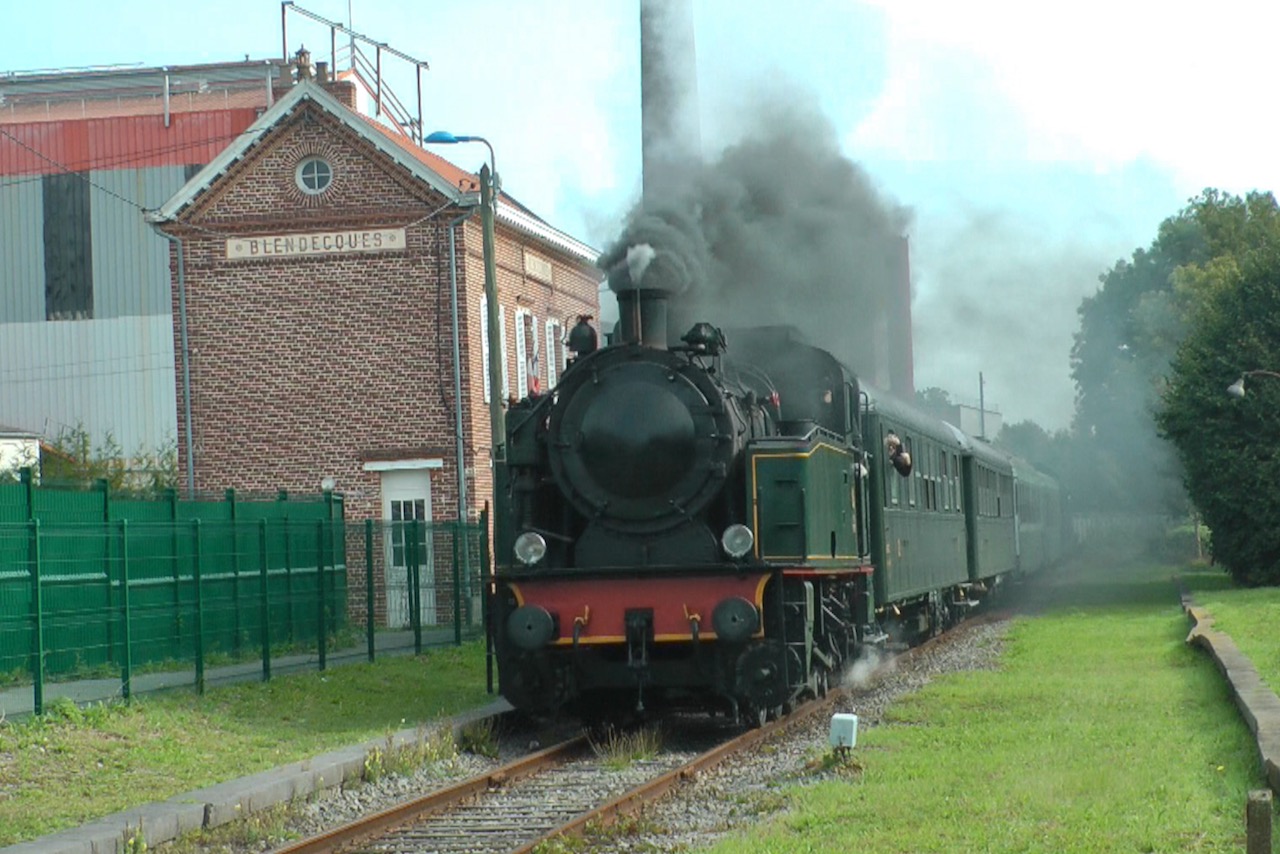
Lyon Line B extended
Around 100,000 people will have better access to the metro, mainly through the multi-mode interchange at Saint-Genis-Laval which brings together metro and buses with parking for 850 cars and 550 cycles. Trains will run at 2min intervals during peak hours; 25,000 passengers/day are expected initially.
Two days earlier, an object had fallen onto the track at Brotteaux during the morning peak causing complete power failure on Line B and partial stoppage on Line A; six trains were immobilised and later evacuated. Safety systems had to be recalibrated and trains repositioned before service could be resumed some three hours later.
Photo: actu Lyon/Nicolas Zaugra.
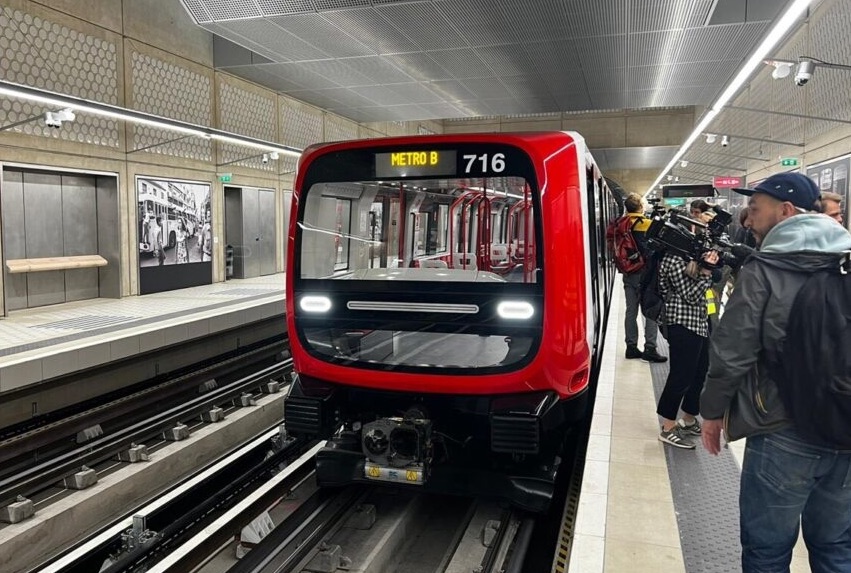
Summer’s end at Morcenx
Southwest France’s Indian summer came to an end on 13th October, though it was still shorts and tee-shirt weather at Morcenx when the 15.18 Bordeaux – Hendaye/Pau called there (opposite), the first southbound train for several hours on this strike day. Formed of two Régiolis EMUs, Z 51507/8 leading, the train arrived a few minutes behind the scheduled 16.18 departure time. Next stop was Dax where the train divided, front portion for Hendaye, rear for Pau.
Recessed in the loop on the right, one of SNCF Fret's dwindling band of BB 7200 No 7345 (below also) had arrived a few minutes earlier on a mixed rake of tanks and flat wagons carrying rail for the engineering work between Marcheprime and Ychoux (see October News).
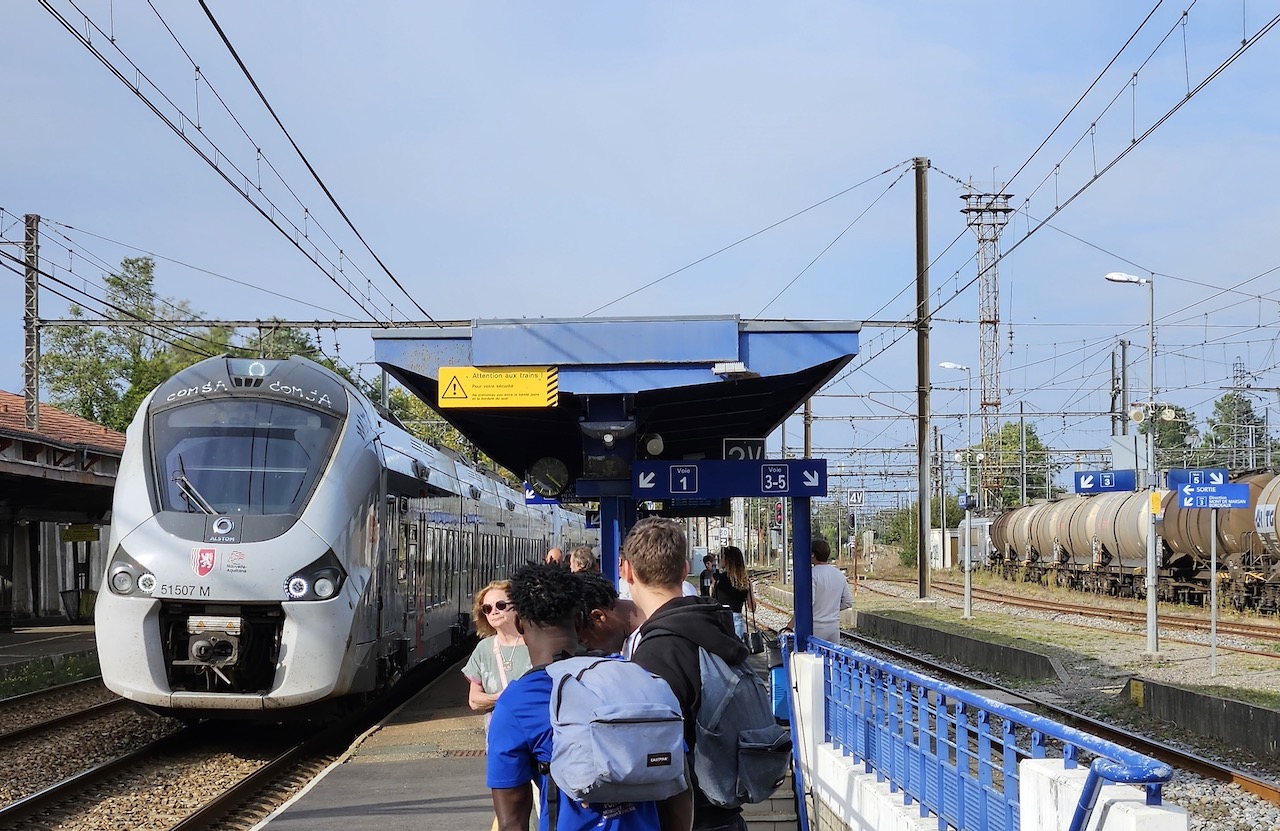
A week later on 20th October there was major disruption due to a power outage at Solferino just north of Morcenx when a freight damaged the overhead. Southbound trains came to a standstill and northbound traffic was held while the situation was assessed. TGV 8571 06.34 Paris – Tarbes was stopped just behind the stricken freight while the following TGV 8531 07.08 Paris – Hendaye was halted in the platform at Ychoux. Some passengers on this train (below right) arranged forward travel for themselves and an informal car-sharing WhatsApp group was set up..
TGV 8534 09.28 Hendaye – Paris was able to pass the affected area at reduced speed, arriving Bordeaux 39min late, as was B 81831/2 on TER 866020 10.43 Mont-de-Marsan to Bordeaux. This train had to reverse out of the branch platform at Morcenx to cross to the Up line at the south end of the station as its usual route via the north crossover could not be accessed due to the power failure. Both southbound TGVs eventually returned to Bordeaux where passengers were offered meals before resuming their journeys on TGV 8541 12.08 Paris – Hendaye departing at 15.35 or a replacement for TGV 8571 some time later. These trains ran wrong-line between Ychoux and Morcenx, reaching their destinations several hours late. Other TGVs were delayed or cancelled, and TER services between Bordeaux, Hendaye, Pau and Mont-de-Marsan were replaced by buses or disrupted throughout the day. Recovery of passengers and trains was hampered by bad weather which swept across Les Landes in mid-morning, while a fatality at Marcheprime late in the afternoon delayed resumption of normal service until 19.33. Photos: Chris Bushell and France3.
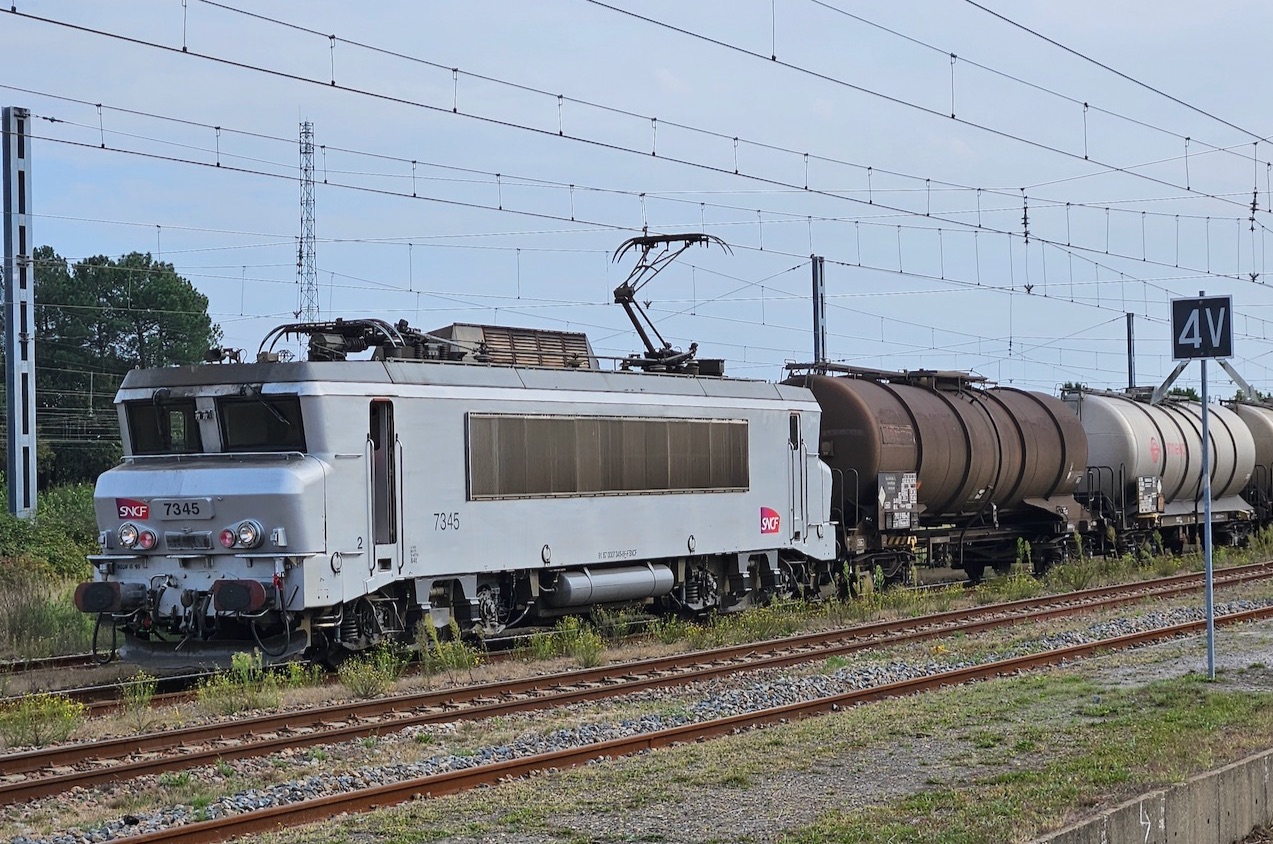
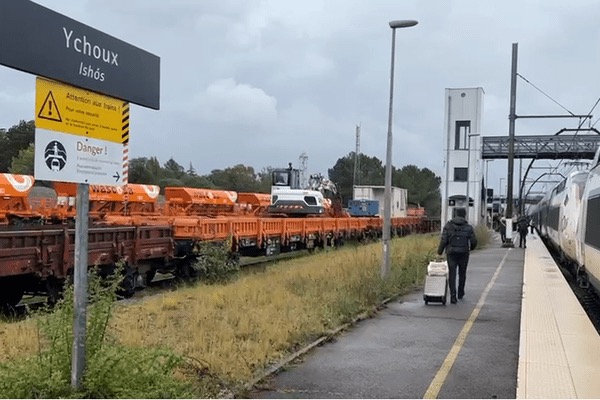
© Peter Lovell & Chris Bushell. The French Railways Society 2023. With thanks to Georges Turpin, Christophe Masse, Jocelyne Bourneuf,
Alan Allbuary and Michel Joindot.
